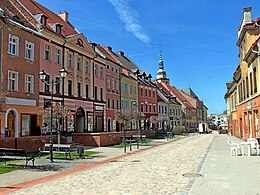Schmiedeberg im Riesengebirge
| Kowary | |||
|---|---|---|---|

Centre of town
|
|||
|
|||
| Coordinates: 50°47′30″N 15°50′0″E / 50.79167°N 15.83333°E | |||
| Country |
|
||
| Voivodeship | Lower Silesian | ||
| County | Jelenia Góra | ||
| Gmina | Kowary (urban gmina) | ||
| Area | |||
| • Total | 37.39 km2 (14.44 sq mi) | ||
| Population (2014) | |||
| • Total | 11,479 | ||
| • Density | 310/km2 (800/sq mi) | ||
| Website | http://www.kowary.pl | ||
Kowary [kɔˈvarɨ] (German: Schmiedeberg im Riesengebirge) is a town in Jelenia Góra County, Lower Silesian Voivodeship, in south-western Poland, with a population of around 12,000 (2014). It lies approximately 14 kilometres (9 mi) south-east of Jelenia Góra, and 93 kilometres (58 mi) south-west of the regional capital Wrocław. The town is famed for its sanatoriums and a miniature park displaying architectural monuments of the Lower Silesian region.
The official site of the town dates the history of Kowary dates to 1148 when semi-legendary miner Laurentius Angelus mined iron ore in the location on the behalf of Polish duke Bolesław IV the Curly, ten years later on the orders of the Polish ruler a mining settlement was founded in the area, the official page of the town also states that the Kowary miners took part in Battle of Legnica in 1241. Other possible date of the start of the town is 1355 and connects it to Ostsiedlung. Publications published in German Empire disputed the origin of Kowary and called it 'Schmedewerk'. In 1355 year Duke Bolko II the Small, the grandson of the Polish king Władysław I the Elbow-high, the last independent Silesian Piast, granted mining privileges to the local miners.
Since 1401 the village belonged to the possessions of the Schaffgotsch family (within bounds of the Crown of Bohemia). As a mining center Schmiedeberg received several privileges and was seat of a vogt (reeve) since 1368. An accord with neighbouring Hirschberg (Jelenia Góra) in 1454 elevated the settlement above the status of a village, it wasn't until 1513 however that Casper Schaffgotsch acquired the municipal law from Bohemian king Vladislaus II against the opposition of Hirschberg. Mining flourished until the Thirty Years' War, when the town was destroyed in 1633. The town's webpage states that the main export partner was Poland, with record trade in 1558, it was also famous for its gunsmiths, with Polish king Sigismund II Augustus ordering 2000 gun barrels (later German publications claimed it was only 200).
...
Wikipedia



